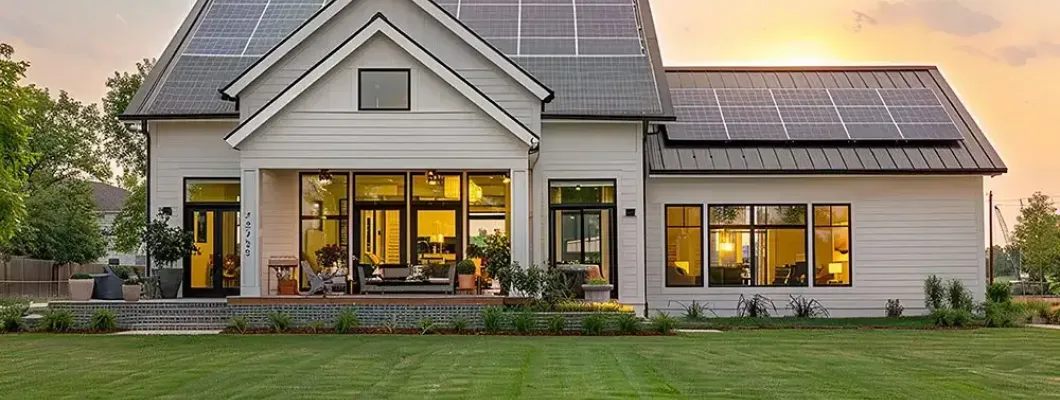Hey, bro, ready to jump into solar power or wondering why your panels aren’t delivering as promised? You’ve probably heard some wild claims—like panels pumping out more juice on cloudy days or charging under streetlights at night. Sounds like something your buddy might swear by over a beer, right? But hold up—some of these “facts” are pure myths that could throw your solar setup off track. Let’s bust the top 10 solar panel rumors with straight-up truths, backed by science, to help you get the most out of your system. Ready? Let’s roll!
Why’s My Solar Panel Voltage So High? It’s Built That Way!
Ever checked your solar panel’s specs and freaked out because the voltage is way higher than advertised? Like, a 12V panel hitting 18-22V? Relax, it’s not a glitch—it’s how panels are designed.
The Myth
Some folks think a 12V solar panel should always output exactly 12V, and anything higher means it’s broken or wrong for their system.
The Truth
Solar panels are designed to output a higher open-circuit voltage (Voc) than their rated voltage. A 12V panel’s Voc is often 21-22V to ensure stable power in cloudy or hot conditions, with the working voltage (Vmp) around 17-18V when connected to a charge controller.
Digging Deeper
Here’s the deal: a 12V panel typically has 36 silicon cells, each producing about 0.6V, so 36 × 0.6 ≈ 21.6V for Voc. In weak light or high heat, voltage drops, so the extra headroom keeps your system humming. Pair it with a Maximum Power Point Tracking (MPPT) controller, and you’ll boost efficiency by 20-30% compared to a basic PWM controller. The National Renewable Energy Laboratory explains that MPPT optimizes power output by dynamically adjusting voltage and current (NREL MPPT Guide). Want to dive deeper into panel specs? Check our guide on solar panel specifications.
Pro Tip
Always check the panel’s Voc and short-circuit current (Isc) to match your controller’s input limits (e.g., a 30V max controller can’t handle a 40V Voc panel). A mismatch could fry your gear or cut efficiency by 10-15%. Use this table to avoid mistakes:
| Spec | What It Means | Why It Matters |
|---|---|---|
| Voc (Open-Circuit Voltage) | Max voltage with no load (e.g., 21V for 12V panel) | Must be below controller’s max input voltage |
| Isc (Short-Circuit Current) | Max current under short circuit (e.g., 6A) | Ensures controller/inverter can handle current |
| Vmp (Voltage at Max Power) | Working voltage (e.g., 17V) | Shows real-world output voltage |
| Imp (Current at Max Power) | Working current (e.g., 5.8A) | Shows real-world output current |
Data Point: Using a PWM controller instead of MPPT can waste 20% of your panel’s potential output.
Cloudy Days Boost Solar Panels? Nope, That’s a Myth!
Heard the buzz that solar panels are secretly better on cloudy days because they “love diffuse light”? Sounds cool, but it’s a total misconception.
The Myth
Some believe solar panels generate more power on cloudy days due to better diffuse light capture.
The Truth
Solar panels do not work better on cloudy days. Clouds slash sunlight intensity to 10-30% of a sunny day (100-300W/m² vs. 1000W/m²), dropping output to 30-50% of rated power.
Digging Deeper
Most panels—especially silicon-based ones—thrive on direct sunlight, which delivers the right wavelengths to generate maximum power. Diffuse light from clouds scatters energy, so less reaches the panel. For example, a 100W panel might produce 80W on a sunny day but only 20-30W when overcast. Newer tech like perovskite-based panels handles diffuse light better (10-15% more efficient than silicon in low light), but even they can’t beat clear skies. For tips on optimizing panel angles for low light, see our guide on optimizing your solar system.
Pro Tip
Choose monocrystalline panels (20%+ efficiency) for better low-light performance. Tilt panels at 30°-45° (based on your latitude) to grab more scattered light. Keep them clean—dust can steal another 10-30% of your output!
Data Point: Cloudy days reduce solar output by 50-70%, but clean, well-angled panels can recover 5-10% more power.

Nighttime Charging with Streetlights? Not Happening!
Ever seen a tiny current flicker on your solar panel under a streetlight and thought, “Whoa, it’s charging!”? Sorry, bro, that’s a pipe dream.
The Myth
Some think solar panels can charge batteries under artificial lights like street lamps at night.
The Truth
Solar panels can’t meaningfully charge under streetlights. Artificial lights produce 1-10W/m² compared to the sun’s 1000W/m², generating less than 1% of a panel’s rated output—far too weak to charge a battery.
Digging Deeper
Solar panels need light in the 400-1100nm wavelength range to generate significant power. Most streetlights (LED or sodium) lack the intensity and full spectrum of sunlight, producing only microamps of current. For example, a 100W panel under a streetlight might output 0.01W—nowhere near enough to charge a 7Ah battery. That tiny current you see? It’s just the panel teasing you, not delivering usable energy. Instead, focus on storing daytime power—check our tips for maintaining LiFePO4 solar batteries.
Pro Tip
Focus on storing daytime power with a LiFePO4 battery and an MPPT controller. For nighttime needs, calculate your load (e.g., 12V LED lights) and size your battery accordingly. Skip the streetlight fantasy and bank that solar energy!
Data Point: Artificial lights yield <1% of a panel’s rated output, while a battery stores 100% of daytime energy for night use.
More Busbars, More Power? Hold Up, It’s Not That Simple!
Seen those panels bragging about “9BB” or “12BB” (busbars) and figured more lines equals more power? Not so fast, buddy.
The Myth
The more busbars on a solar panel, the better it performs, so always grab the one with the most.
The Truth
More busbars improve efficiency by 2-5%, but only if your system (inverter and controller) can handle the extra current. Otherwise, it’s just extra cost without the payoff.
Digging Deeper
Busbars are like electrical highways, collecting current from the panel’s cells. More busbars (e.g., 12BB vs. 5BB) reduce resistance and spread current evenly, boosting efficiency. For instance, a 100W 5BB panel might hit 18% efficiency, while a 12BB reaches 20%. But if your inverter’s max input current (Isc) is too low, you’re wasting that potential. Plus, 12BB panels cost 15-20% more, so it’s not always worth it for small setups.
Pro Tip
For home systems, 9BB panels offer the best bang for your buck. Check your inverter’s Isc rating on the panel’s spec sheet to avoid overload. Always pair with an MPPT controller to maximize those busbar gains.
Data Point: 12BB panels boost efficiency by 3-5% but cost 15-20% more than 5BB.
.webp)
No Load, No Power? Let’s Sort This Out!
Wondering if your solar panel stops working if it’s not hooked up to a battery or appliance? Some think panels only generate power when connected to a load. Time to clear the air.
The Myth
Solar panels need a load (like a battery or device) to produce electricity, or they just sit idle.
The Truth
Solar panels generate power as soon as sunlight hits them, whether connected to a load or not. Without a load, the energy goes to waste as an open-circuit voltage (Voc).
Digging Deeper
When sunlight hits a panel, photons excite electrons in the silicon cells, creating a voltage and potential current. No load? You get Voc (e.g., 21V for a 12V panel) but zero current, so no power is delivered. For example, a 100W panel in full sun, with 4 hours of peak sunlight, could waste 400Wh/day if not connected—enough to charge your phone dozens of times! Connect it to a battery via an MPPT controller, and you’ll capture that energy for later.
Pro Tip
Pair your panel with an MPPT controller and a LiFePO4 battery to store daytime power. For small setups, try DC loads (like 12V camping lights) to skip the inverter and save 10-15% on conversion losses.
Data Point: Unconnected panels waste hundreds of watt-hours daily; an MPPT controller recovers 20% more power than PWM.
Wrap-Up: Don’t Let These Myths Derail Your Solar Setup!
There you go, bro—no more falling for solar panel myths! High voltages are normal, cloudy days cut output, streetlights don’t charge, busbars need system matching, and panels work even without a load. To keep your system humming:
- Check specs: Ensure Voc and Isc match your controller and inverter.
- Go MPPT: Boosts efficiency by 20-30%.
- Clean regularly: Dust can steal 10-30% of your power.
- Add a battery: Store daytime energy for night use.
Ready to build a myth-proof solar system? Drop your questions in the comments, and your solar bro will help you nail it!
FAQ: Your Burning Solar Questions Answered
Why is my solar panel’s voltage higher than advertised?
It’s the open-circuit voltage (Voc), designed higher (e.g., 21V for a 12V panel) to ensure stable output in weak light or heat. Match it to your controller’s max input.
Do solar panels work better on cloudy days?
No, clouds cut output by 50-70%. Monocrystalline or perovskite panels perform slightly better in low light, but sunny days are best.
Can streetlights charge my solar panel at night?
Nope—artificial lights produce <1% of a panel’s rated output. Use a battery to store daytime power instead.
Are more busbars always better?
More busbars (e.g., 12BB vs. 5BB) boost efficiency by 2-5%, but only if your inverter and controller can handle it. 9BB is often the sweet spot.
Do I need a load for my panel to generate power?
No, panels produce power with sunlight alone, but without a battery or load, that energy is wasted. Use an MPPT controller to capture it.




Leave a Comment